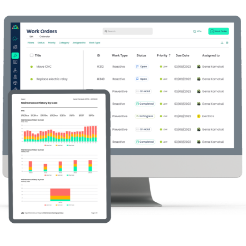
Why Work Order Prioritization is Important for Maintenance Teams
Every maintenance team is under pressure to do more with less. Unplanned downtime is often attributed to poor maintenance planning and a lack of clear task prioritization. The impact is staggering. A single hour of downtime in manufacturing can wipe out thousands of dollars in lost production, strained labor, and missed delivery targets.
This is why work order prioritization matters. It is the process of ranking maintenance tasks by urgency, safety, and operational impact, ensuring that critical jobs are addressed before they disrupt production or compromise compliance. Without it, teams risk wasting resources, resorting to reactive firefighting, and incurring unnecessary costs.
This article breaks down why prioritization is vital for modern maintenance teams, the hidden risks of ignoring it, and proven methods to build a prioritization system that improves uptime, strengthens efficiency, and supports long-term reliability.
What is Work Order Prioritization?
Prioritizing a work order involves arranging maintenance work orders from most important to least, ensuring that the most critical job is addressed first. It makes sure there's a system, getting teams out of the headwind that comes from thinking everything is an emergency, which generally causes frustration and lost time.
How Work Order Prioritization Works
Task priorities are generally decided on based on three main criteria: urgency, asset importance, and resource availability. Timeliness describes when an issue needs to be resolved (before work is disrupted). Equipment criticality, in turn, defines the importance of the asset to the overall operation. Resource availability considers the presence of necessary tools, spare parts, and personnel required to perform the job effectively.
Role in Reliability and Downtime Prevention
Prioritization enhances reliability by keeping high-impact equipment well-maintained. This cuts down unplanned downtime and unexpected breakdowns, and maximizes production.
Reactive vs Proactive Approaches
Reactive prioritizing occurs when a team only starts to prioritize tasks after a failure, often resulting in rash decisions and higher costs. Proactive Prioritization, however, is about using data, checklists, and being planful to prevent problems before they crop up! Adopting the proactive approach results in the maintenance team moving from firefighting to a more efficient planned maintenance approach.
Common Challenges When Work Orders aren’t Prioritized
Unplanned Downtime and Production Losses
When maintenance tasks are handled without clear prioritization, critical issues often go unnoticed until they lead to failure. This results in unplanned downtime that disrupts operations and leads to costly production losses. Even short interruptions can have a significant impact on output and delivery schedules.
Wasted Labor and Technician Frustration
Whenever technicians have to figure out what the next task should be, the time used is unproductive and time lost. Organizations become frustrated when equipment sits idle because of wasted time and effort on lower-priority maintenance tasks. This erodes morale and has a direct impact on the maintenance team's productivity and the company’s bottom line.
Safety Risks and Compliance Failures
Failing to address safety-related work orders can create unsafe conditions and increase the risk of compliance violations. In the industry, regulators require that “safe critical” automation and tasks be conducted in a timely fashion; if not, this results in penalties and legal actions.
Hidden Costs
Ignoring prioritization can lead to costs that are not immediately apparent. From increased overtime and expedited parts orders to loss of customer trust due to missed deadlines, the financial impact is substantial. Over time, these hidden costs far exceed the effort required to implement a clear prioritization system.
Customer and Service Quality Impact
Service quality falls when there are delays with critical work orders. This results in dissatisfaction among your customers, missed deadlines, and reputational damage that has a negative impact into the future. Negative reviews and cancelled orders are very difficult to turn around and recover.
Inefficient Use of Spare Parts and Materials
Poor prioritization inevitably leads to hastily placed orders, excessive parts turnover, and emergency purchases. This results in wasted money, increased maintenance budgets, and disrupted inventory management across the company.
Why Work Order Prioritization is Crucial for Maintenance Teams?
Improves Efficiency
The work order prioritization process ensures that the proper jobs are completed at the right time. Rather than acting as if every task is of equal urgency, the team can focus on doing high-impact work that matters. By providing a solid framework, it removes ambiguity and minimizes uncertainty, allowing technicians to focus on solving the most pressing issues in less time.
Reduces Downtime
When it comes to mission-critical equipment failure, time is of the essence. With prioritization, maintenance crews will be able to attend to malfunctions as they arise without concern about downtime and low productivity. By separating urgent from everyday items, companies can avoid costly interruptions and ensure the smooth operation of production.
Optimizes Labor Resources
Maintenance personnel are often understaffed and lack sufficient tools and equipment. Without proper priority, technicians work on activities that are not as important as the most critical asset offline at the time. There is a ranking system that decides where workers, parts, and expertise are used to provide the most value.
Supports Safety and Compliance
Work orders aren’t all about productivity. Others are directly related to workplace safety and regulatory requirements. Prioritizing ensures that safety issues will never be left behind by taking more convenient shortcuts. This mitigates worker risk and helps organizations avoid compliance fines.
Improves Communication and Transparency
Prioritizing the work order also enhances cooperation between maintenance and operations. And by removing the guesswork and disputes about what gets done first, the model establishes clear parameters. The two departments can come together to discuss common objectives, aiming to develop trust between the teams and establish accountability, while improving performance.
Best Practices for Effective Work Order Prioritization
Establish a Priority Matrix
A simple yet effective starting point is creating a priority matrix with categories such as "urgent," "high," "medium," and "low." This framework enables teams to quickly identify which tasks require immediate attention and which can be scheduled for later. Clear categories remove guesswork and bring consistency to daily decision-making.

Use Asset Criticality Ranking
Not all assets hold equal importance to operations. By prioritizing assets based on their hierarchy, you can ensure that work orders for high-value or mission-critical equipment are addressed first. This strategy prevents situations where minor tasks delay the completion of others that directly affect revenue or safety.
Leverage Data-Driven Insights from CMMS or EAM
Modern CMMS and EAM systems provide real-time data that can guide prioritization. Automated alerts, performance trends, and predictive analytics highlight which assets are most at risk. Using data rather than intuition ensures more accurate and reliable prioritization decisions.
Involve Cross-Functional Teams
Prioritization works best when input is gathered from maintenance, production, and safety teams. Working together means that they don't make decisions in a vacuum; instead, they consider the broader perspective. This eliminates confusion and gets teams on the same page, pulling in the same direction.
Reassess Priorities Regularly
Work order priorities are not static. Equipment conditions, production schedules, and safety requirements are subject to change over time. Regularly reassessing and updating priorities helps teams stay responsive to new challenges and ensures that resources are always directed where they are needed most.
Build a Prioritization Scoring Model
A prioritization scoring model assigns weights to key factors, including safety, production impact, cost, and compliance. By comparing each work order to these criteria, maintenance teams can easily prioritize tasks. This helps to eliminate bias, create equity, and target resources proven to make the most difference.
Use Checklists and Templates
Checklists and templates make prioritization easy, providing teams with a pattern they can use repeatedly as needed. Instead of debating which is first, teams can follow more prescriptive guidance that defines urgency, criticality, and risk. Offering tailor-made templates helps companies standardize their work processes, enhance consistency, and expedite decision-making across multiple sites or departments.
Common Mistakes in Prioritization
Overloading the “Urgent” Category
Too many work orders are often marked as urgent. When everything is marked as high priority, it means that a team can no longer distinguish between actual emergencies and routine requirements. This diminishes the effectiveness of prioritization and leads to critical issues not being addressed.
Ignoring Technician Input
Technicians, being closest to the equipment, are often the first to detect early warnings. Overlooking their input can lead to misaligned objectives, wasted resources, and the potential to undervalue serious risks while overvaluing less critical tasks.
Failing to Update Priorities
The priorities of the work orders should be changed if the circumstances have evolved. Failing to adjust or open up from using traditional ratings systems, however, can lead to inefficiencies when the performance of assets changes or the demand for output increases. Frequently re-evaluating priorities also helps to ensure that maintenance personnel remain focused on the most critical tasks and adapt quickly to new challenges.
The Role of CMMS in Work Order Prioritization
Automating Prioritization
Work orders are typically classified by their importance and the time at which they should be performed, but software automation reduces the complexity of this task. Rather than making a judgment call, the platform features set rules to ensure that no urgent or high-value work is overlooked.
Key Features that Support Prioritization
There are contemporary CMMS solutions that can generate custom rules, automatic alerts, visual management dashboards, and some that also include AI recommendations. These solutions provide immediate insight into asset health, labor availability, and operational risks, enabling maintenance leaders to make informed decisions quickly and effectively.
A Practical Example of Work Order Prioritization
Efficient maintenance is crucial for safety and production. A CMMS streamlines this by automating work order prioritization. For critical tasks, it assigns high priority, instantly notifies relevant personnel, and optimizes schedules. This ensures safety-related repairs are addressed promptly, reducing accidents and downtime. By leveraging a CMMS software, organizations enhance safety, reduce costly disruptions, and optimize resource allocation. It shifts focus from reactive to proactive maintenance, ensuring essential work is never delayed and less critical tasks are handled efficiently without compromising core business functions.
Effective Maintenance with Work Order Prioritization
Prioritizing work orders is not just a method of staying organized, but the heart of good maintenance management. Prioritize your work based on the urgency, criticality of assets, and productivity impact to increase uptime, accomplish more, and maintain a safer workplace.
The long-term benefits are significant. Organizations that prioritize effectively experience higher equipment availability, improved labor utilization, and reduced compliance risks. Instead of constantly reacting to emergencies, maintenance teams can operate with greater control and confidence, knowing that the most critical work is always handled first.
Now is the time for teams to take a closer look at how they manage work orders. Examining the current process can reveal gaps that result in time losses and hidden expenses, which can be addressed through structured priorities supported by today’s CMMS capabilities. Implementing a structured approach to prioritizing work, combined with the use of modern computerized maintenance management (CMMS) solutions, is a pragmatic approach that also benefits all departments.
TABLE OF CONTENTS
Keep Reading
Every maintenance professional faces it sooner or later — that critical time when an aging ...
18 Nov 2025
The term 'best' is often used loosely, without a clear understanding of its context or ...
14 Nov 2025
In the not too distant past, maintenance strategies have been defined by reaction—fixing ...
13 Nov 2025
Tax season is the time of year that often sends a ripple of anxiety through many of us. The ...
11 Nov 2025
Selecting a Computerized Maintenance Management System (CMMS) can, at first glance, be an ...
4 Nov 2025
In healthcare facilities, equipment uptime involves more than achieving operational ...
31 Oct 2025
Companies are subject to economic ups and downs, also known as economic volatility. Today, ...
30 Oct 2025
Maintenance challenges are a constant struggle, with unplanned downtime costing manufacturers ...
27 Oct 2025
Last winter, a maintenance technician at a U.S. paper mill ignored a predictive alert that ...
10 Oct 2025
Many organizations proudly say they “have a CMMS,” but ownership alone doesn’t equal ...
9 Oct 2025
The implementation of simple, yet powerfully effective, checklists has repeatedly ...
3 Oct 2025
In manufacturing, every second counts. When production stops, whether due to scheduled ...
2 Oct 2025
The increasing cost of maintenance, lack of accountability, and siloed systems leave many ...
30 Sep 2025
Preventive maintenance is one of those things maintenance teams know they need to do, but it ...
26 Sep 2025
Public services are essential to daily life. The provision of safe roads, functional transit, ...
25 Sep 2025
For most manufacturing facilities, a major focus of their maintenance teams revolves around ...
24 Sep 2025
Have you ever tried explaining to the CEO why the production line has been down for hours ...
18 Sep 2025
Over the past few decades, the hotel industry has undergone a dramatic transformation. ...
16 Sep 2025
Profitability is at the top of the list for manufacturing organizations when conversations ...
12 Sep 2025
Lean manufacturing is a goal that organizations strive for in their quest for operational ...
11 Sep 2025







